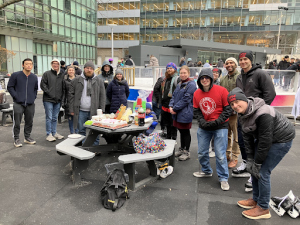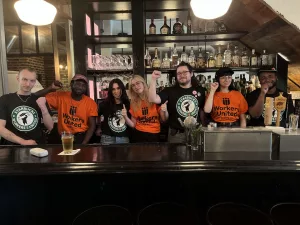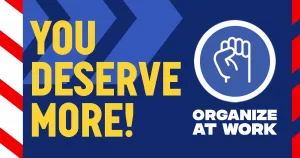Workers around the country are standing up for their rights, quitting hostile workplaces en masse as a form of protest and leaving behind signs taped to the front door explaining why they’ve had enough. Here are three examples of fast food and retail workers across the country, demanding better conditions at their workplace:
1. An Entire Team at a Dollar Store Store Quit Together
The entire team of Dollar General workers in Eliot, Maine quit to protest low pay and chronic understaffing at their store.
Got real tired of all those “no one wants to work” signs on closing stores. This is how my coworker and I quit our job today. Speak truth to power! pic.twitter.com/MlHRD9wvu8
— ☭ ♥️Berndt♥️Erikson♥️☭ (@Berndt_LVS) May 3, 2021
The Dollar Tree workers left behind signs taped to the front door of the establishment, which read:
- “Closed indefinitely because Dollar General doesn’t pay a living wage or treat their employees with respect.”
- “Capitalism will destroy this country. If you don’t pay people enough to live their lives, why should they slave away for you?”
- “Google “General Strike” and learn how we can take our power back! To our loyal customers who treated us with respect, thank you. We love you! ❤️”
2. Chipotle Employees Take a Stand Against “Borderline Sweatshop Conditions”
An extremely overworked crew, including managers, at an constantly understaffed Chipotle at the University of Pennsylvania, quit their jobs together.
the workers at this chipotle said no more exploiting us pic.twitter.com/a99FHWc5vq
— brands getting owned (@BrandsOwned) May 8, 2021
Former manager Brian Healy describes the longstanding hellish work conditions and corporate indifference that led to this collective resignation.
On days when they needed 13-14 workers in the store, they usually had about six to eight, often resulting in workers doing 10-12 hour shifts without any breaks to eat.”
Brian and his coworkers left behind a printed sign on the front door that alluded to their terrible work conditions, poor pay, and Chipotle’s lack of concern for their workers’ well-being:
Attention Chipotle Customers.
Want to know why we’re closed?
Ask our corporate offices why their employees are forced to work in borderline sweatshop conditions for 8+ hours without breaks. We are overworked, understaffed, underpaid, and underappreciated. Almost the entire management and crew have walked out until further notice.
People should be > profits.
Repost this if you agree.
Help spread awareness
#freechipworkers
#fairwages
#fairhoursfairwages
#giveusabreak.
Not surprisingly, this isn’t the first time Chipotle’s exploitation of its workers has made national news. In fact, New York City is currently “suing the fast-casual chain for nearly half a billion dollars, for 600,000 separate violations of workers’ rights.”
3. Workers at Several Wendy’s Walked Out Together
Like workers at Chiptole and Dollar Tree, the crew at a Wendy’s in Wadesboro, North Carolina walked out in solidarity to protest the low pay and poor workplace conditions.
— The Nap Ministry (@TheNapMinistry) May 7, 2021
And now…
Signs From Companies Whining and Blaming Workers, Instead of Improving Work Conditions and Paying a Living Wage
While workers around the nation are expressing their displeasure with their starvation wages, lack of healthcare and other terrible work conditions, it appears that the employers aren’t getting the message. Instead of addressing the demands of their workers and making improvements, employers are falsely blaming closures on workers not wanting to work anymore because of enhanced federal unemployment benefits.
Here are two examples of workplaces (and a politician) that just don’t get it:
Denny’s Complaining “No One Wants to Work Anymore.”
Hi, @DennysDiner ! Are you aware that your managers are putting up these signs? Please thank them for confirming that, instead of paying a living wage to the people who keep you in business, your company prefers to whine about workers who refuse to become indentured servants. pic.twitter.com/DnM4t14BkK
— BeaglesResist, House of Pfizer (FDA Approved)🌈 (@BeaglesResist) May 9, 2021
Hardee’s Explaining They’re Closed Due to NO Staff
Nope. You analysis is flawed. Would you work for 3.89/hour, no benefits, during a global pandemic, interacting all day w maskless people who don’t believe in covid?
— red light hive (@redlighthive) April 30, 2021
A More Accurate Sign for Companies
Instead of the “We are closed due to NO staff” and “No one wants to work” signs that are showing up at fast-food, restaurant and retail establishments around the nation, we think the following is a more accurate sign that employers should use:
No one wants to work anymore #fightfor15 pic.twitter.com/DbhQMspcVi
— Fight For 15 (@fightfor15) May 10, 2021
The Largest Labor Movement in Modern American History?
Wealth inequality has been a persistent problem in the United States; the COVID-19 pandemic worsened this already enormous wealth gap between poorly compensated “essential workers” and those that make massive profits off the hard-work and labor of the same “essential workers.” According to a recent report, last year (2020), millionaire executives of some of the American companies with the lowest-paid workers saw an average pay raise of 29% while their workers saw a 2% decrease in pay.
We're literally watching the largest labor movement in modern American history happen in the form of paper signs taped to the windows of fast-food and fast-casual restaurants! pic.twitter.com/yg393GZG0P
— Devita Davison (@DevitaDavison) May 9, 2021
Given this rampant economic injustice, it’s not surprising that large numbers of workers are protesting by terminating their relationships with their exploitative employers. But while employees walking out and quitting in solidarity seems like a great victory (workers sticking it to the man!), these isolated acts of protest aren’t enough to create lasting change.
The Need for Organizing and Organizers in this Movement
Unfortunately, in most cases of employees quitting a workplace in protest, without a proper plan of attack, workers are not able to get their demands met by employers. Bosses often treat their workforce as expendable and easily replaceable; instead of addressing the valid pains of their workers, employers just try to replace them in the hopes that they never have to actually address any issues or concerns.
As Boots Riley explains in an Instagram post, an entire crew of workers quitting and leaving the premises in solidarity gives up the “leverage needed to win the strike.”
In other words, in situations like the ones described above, workers have the upper hand; they can use this advantage to successfully negotiate better pay and improved workplace conditions. However, when they leave the premises after quitting, they cede their bargaining power to the bosses who just focus on hiring replacements. With an organizers guidance, workers can retain their leverage by not leaving the workplace and instead striking and block access to it till their demands are met.
Before this, we were already in the biggest strike wave in the US in the last 80 years with 1200 strikes in the US between March 2020 and January 2021. Many of them wildcat strikes, and some with radical goals.
Boots Riley, @bootsriley
Now with this, I don’t know what that number has risen to.
It’s been pointed out in the comments that some of these places have everyone quitting and leaving the premises, which actually gives up the leverage needed to win the strike (in most cases, you have to make sure they don’t replace you by blocking access).
What this points to is the fact that these places need organizers. The people are ready to fight and are gonna fight with or without organizers, how effective it is will be determined by their connection and access to the strategy that organization provides. We need to be able to turn folks into organizers and communicate the needed info.
Time for radicals to help coordinate, synchronize and radicalize.
Get news about strikes happening all over the US at paydayreport.com
Examples like the ones described above, underscore the need for organizers. Organization connects workers and arms them with strategy. If you are interested in organizing your workplace to secure better working conditions, as well as higher compensation and other benefits for yourself and your fellow workers, please fill out our form to talk to an organizer today.




